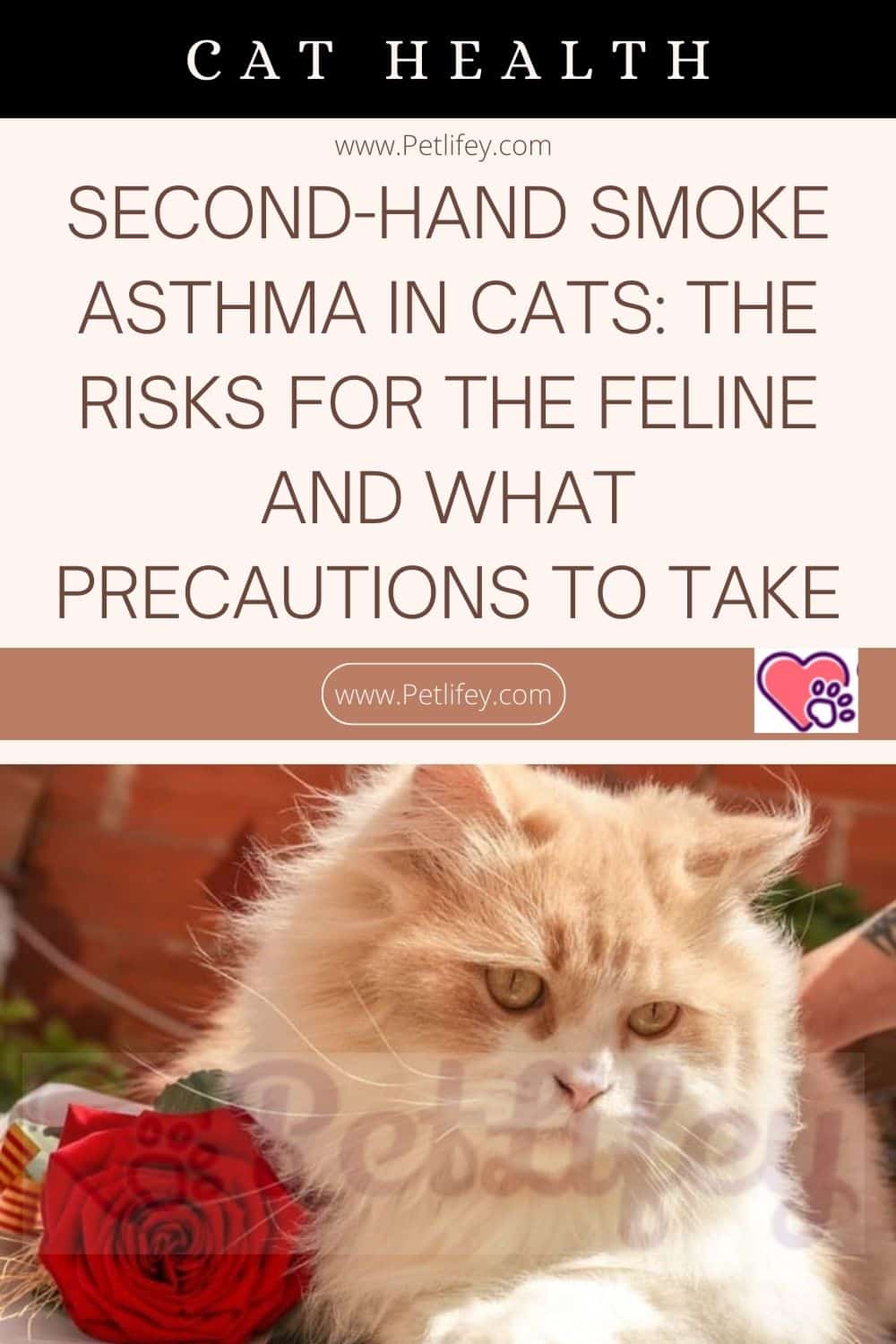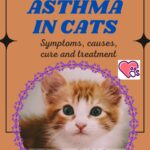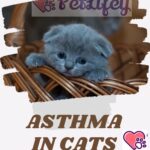Second-hand Smoke Asthma in Cats: Understanding the Risks and Precautionary Measures
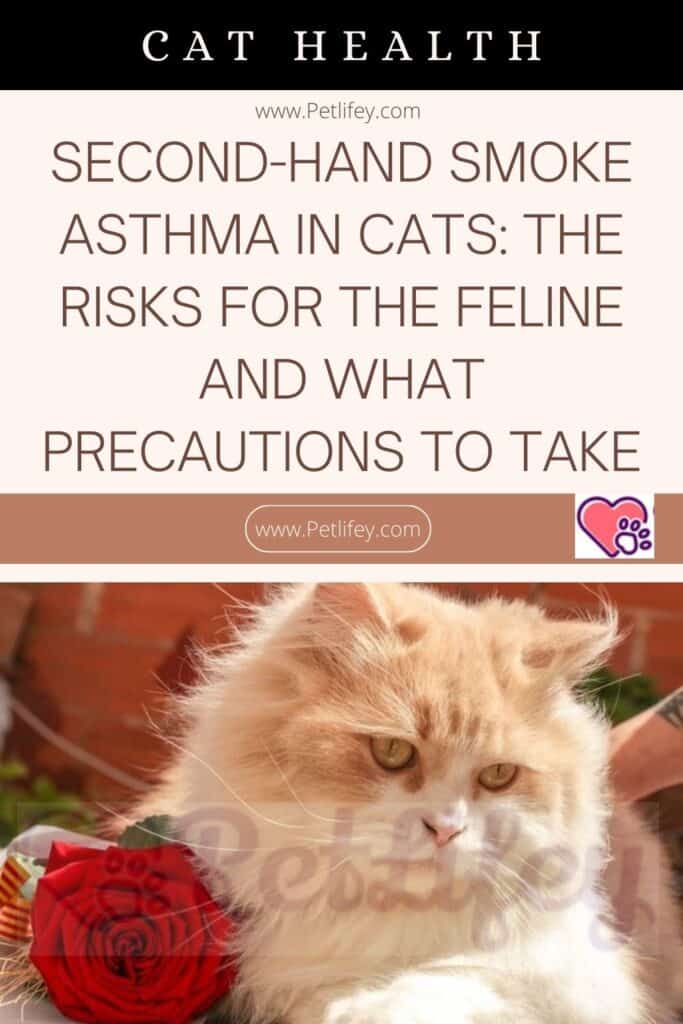
Secondhand smoke poses significant health risks for everyone in its vicinity, and that includes your pet cats. Just as humans can suffer from the effects of secondhand smoke, cats are equally, if not more, vulnerable to these dangers. The smoke lingering in the air contains a variety of toxic substances that can lead to respiratory problems in cats, and one particular concern is the development of feline asthma, a condition that hinders a cat’s ability to breathe normally.
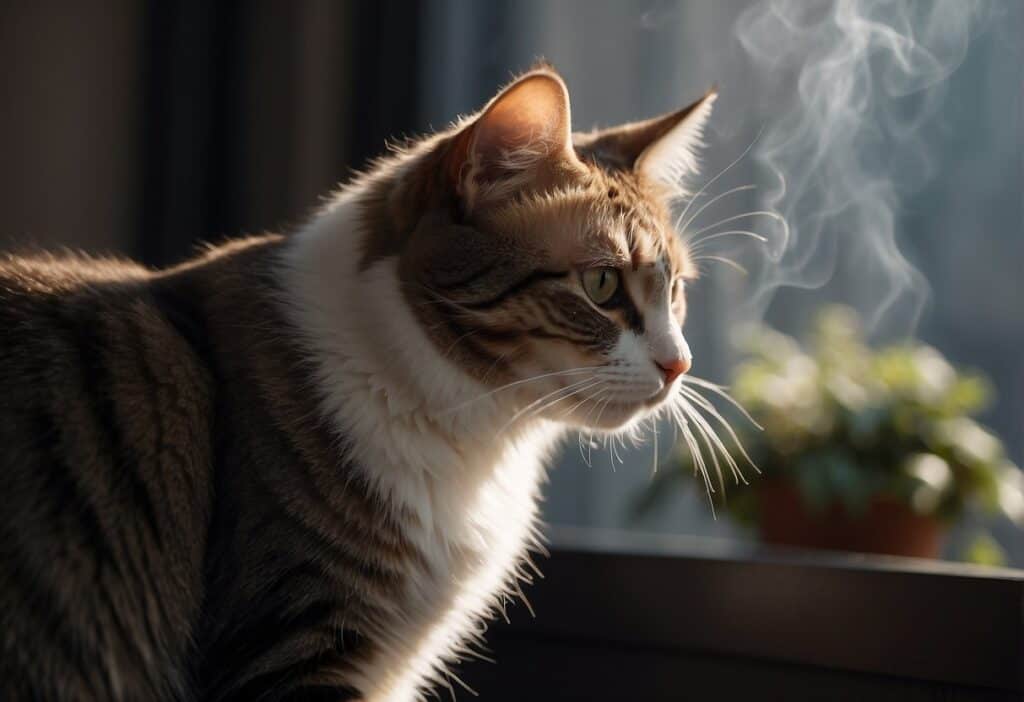
Your cat’s health can be seriously compromised by the inhalation of secondhand smoke. Asthma in cats manifests through symptoms such as wheezing, coughing, and labored breathing, which may indicate an allergic reaction to inhaled particles. If your cat is displaying signs of respiratory distress, it could be a reaction to environmental pollutants, including tobacco smoke.
To safeguard your cat’s well-being, consider taking precautions to minimize their exposure to secondhand smoke. This can entail smoking outside away from your cat or eliminating smoking in the home altogether. Ongoing exposure to tobacco smoke not only leads to respiratory issues like asthma but may also increase the risk of more severe conditions, such as lung disease and certain types of cancer. By being aware of the impact of secondhand smoke on your cat’s health, you can take steps to ensure a cleaner and safer environment for your beloved feline friend.
Understanding Asthma in Cats
Feline asthma is a respiratory condition that can significantly impact your cat’s health, particularly when exposed to triggers like second-hand smoke. Understanding the causes and recognizing the symptoms are critical for managing the disease effectively.
Causes of Feline Asthma
Feline asthma, similar to human asthma, is often triggered by allergens in the environment. These can include:
- Dust
- Pollen
- Mold spores
- Smoke from cigarettes and cigars
When your cat inhales these allergens, their immune system may overreact, causing inflammation in their airways, leading to narrowed passages and difficulty breathing.
Symptoms and Diagnosis
Awareness of the following symptoms is vital for prompt diagnosis and treatment:
- Wheezing or Labored Breathing: Difficulty in breathing or audible wheezing can be a sign of an asthma attack.
- Cough: A persistent cough may be observed, which can sometimes be mistaken for a hairball.
- Lethargy: Decreased energy levels or reluctance to play.
- Rapid Breathing: Increased effort to breathe, often with an open mouth.
Diagnosis typically involves a physical examination, review of symptoms, and may include diagnostic tests such as x-rays or lung function tests to check for signs of bronchitis or other lung-related issues. Mucus from the lungs might be examined for indications of infection or inflammation.
Properly managing your cat’s environment and reducing exposure to known triggers, especially tobacco smoke, is crucial to prevent exacerbation of asthma symptoms and associated health risks like lung cancer.
The Impact of Second-Hand Smoke on Cats
In homes where smoking is a regular activity, your cat’s health is at risk due to prolonged exposure to secondhand and thirdhand smoke. These environmental toxins can lead to significant respiratory issues and other health complications.
Effects of Tobacco Smoke on Feline Health
Second-hand smoke is a complex mixture of gases and fine particles. It contains numerous toxic chemicals and carcinogens that can seriously affect your cat’s health. When you smoke, the involuntary inhalation of smoke by your cat can result in nicotine poisoning and the accumulation of toxins in their system. These toxins are known to cause a range of health issues:
- Lung Problems: Prolonged exposure can lead to chronic respiratory problems and diseases such as lung cancer.
- Oral Health: Cats groom themselves by licking their fur. This habit can cause them to ingest toxic substances present in environmental tobacco smoke residue, increasing the risk of oral cancers.
Comparing Second-Hand and Third-Hand Smoke
While second-hand smoke refers to the direct inhalation of smoke from burning tobacco products or exhaled by a smoker, third-hand smoke constitutes the residual nicotine and other chemicals left on indoor surfaces by tobacco smoke. Your cat can easily come into contact with these residues:
- Fur Contamination: Smoke particles settle on your cat’s fur, which can be ingested during grooming.
- Surface Residues: Residual toxins from smoke can linger on carpets, furniture, and other household surfaces, which your cat may encounter.
Respiratory Problems and Smoking Households
Respiratory complications are common in cats living in smoking environments:
| Condition | Description |
|---|---|
| Asthma | Exposure to cigarette smoke can trigger asthmatic episodes. |
| Bronchitis | Inflammation of the air passages can be aggravated by smoke. |
| Pneumonia | Cats may experience increased susceptibility to infections. |
Reducing Exposure: To minimize these risks, you should smoke outside and away from your cat, ensuring they live in a clean, fresh, and ventilated environment free of tobacco smoke.
A Closer Look at Third-Hand Smoke Dangers
When it comes to your feline friends, understanding the pervasive nature of third-hand smoke is essential for their health. The residue left by smoke can linger on surfaces and pose significant risks.
Chemical Residue in the Environment
Third-hand smoke refers to the tobacco smoke contamination that remains after the cigarette has been extinguished. This toxic residue adheres to surfaces such as furniture, carpets, and drapes in your home. It comprises numerous hazardous chemicals, including those known to cause cancer. Unlike smoke, this residue is not always detectable by scent, meaning it can accumulate and persist undisturbed for long periods.
The Risks Associated with Grooming Behaviors
Cats are natural groomers, often licking their fur to clean themselves. This behavior increases their risk of ingesting these toxic substances. Since third-hand smoke particles are microscopic, they easily adhere to a cat’s fur and paws. Continuous exposure and grooming can lead to the ingestion of harmful chemicals, potentially increasing the risk for health issues such as lymphoma or other forms of cancer. To protect your pets, it’s crucial to maintain a smoke-free environment, keeping their grooming habits safe from these invisible dangers.
Precautionary Measures to Protect Feline Health
Protecting your cat from the risks associated with second-hand smoke involves creating a smoke-free environment and implementing strategies to minimize exposure. These measures are crucial for ensuring the respiratory health and overall well-being of your feline companion.
Creating a Smoke-Free Living Space
- Implement a No-Smoking Policy: Designate your home as a smoke-free area to eliminate the risk of second-hand smoke exposure. Smoking outside, away from your cat, significantly reduces the amount of smoke your pet inhales.
- Utilize Air Purifiers: Invest in air filters or air purifiers certified by the Food and Drug Administration (FDA) to reduce airborne particles and maintain cleaner indoor air.
Strategies to Minimize Exposure
- Regular Cleaning: Routinely steam clean carpets, upholstery, and your cat’s bedding to remove smoke particles and residue.
- Personal Hygiene: After smoking, change your clothes to prevent transferring smoke residue to your cat during cuddling or playtime.
- Awareness in Public Spaces: Be mindful of your cat’s exposure in public areas and ensure it remains in smoke-free zones for its protection.
Smoking Cessation and Pet Health
Quitting smoking not only improves your health but significantly benefits the well-being of your pets. Secondhand smoke can cause respiratory problems in animals, just as it does in humans, and felines, in particular, are vulnerable to asthma and other smoking-related conditions.
Benefits of Quitting Smoking for Pet Owners
Quitting smoking enhances the environment in which your pets live. Reduction in exposure to secondhand smoke corresponds to a decrease in the risk of respiratory issues like asthma and lung disease in cats. As a pet owner, you’ll also notice a decline in prevalence of symptoms such as coughing or sneezing in your pets. A smoke-free home is optimal for maintaining the pulmonary health of your feline friend.
- Healthier Respiratory Function: Minimized risk for asthma and lung diseases.
- Improved Overall Well-being: Better quality of life for you and your pets.
Quitting smoking also lessens the chance of your pets suffering from smoke-related diseases, supporting their longevity and preventing potential frequent visits to the veterinarian.
Help and Resources for Smokers
To support your journey towards quitting smoking, you’re encouraged to seek help and advice. Various resources are available:
- Quitlines: Telephone support from trained professionals.
- Support Groups: Mutual aid from fellow individuals on the same path.
- Medical Advice: Guidance from healthcare providers and veterinarians on how quitting improves pet health.
Starting the process is often the hardest part, and sustained effort is key to staying smoke-free. Remember, support is readily available:
- Contact local health departments for smoking cessation programs.
- Schedule a consultation with your doctor for personalized advice.
- Reach out to online support communities for encouragement.
By taking advantage of these resources, managing your smoking cessation can become more achievable, resulting in a healthier environment for both you and your pets.
Veterinary Care and Regular Check-Ups
Securing the health of your cat involves regular veterinary visits and being proactive about potential risks, such as those from second-hand smoke. Appropriate medical care can mitigate the health issues caused by smoke exposure.
When to Consult a Veterinarian
You should consult a veterinarian if you notice symptoms of respiratory distress in your cat, such as coughing, wheezing, or difficulty breathing. Cats with a smoky environment exposure are more susceptible to respiratory illnesses and may develop conditions like asthma. Regular check-ups help in early detection of smoke-related health problems, including heart disease, immune system impact, and various cancers such as oral cancer and squamous cell carcinoma. Prompt veterinary attention is crucial, particularly if there’s swelling in areas like the lymph nodes, which may indicate more severe health issues.
Treatment Options for Smoke-Affected Cats
Upon diagnosis, your veterinarian may recommend a range of treatment options tailored to your cat’s condition:
- Medication: For managing asthma and respiratory issues, inhalers and corticosteroids might be prescribed.
- Lifestyle Changes: Ensuring a smoke-free environment is crucial.
- Weight Management: Overweight cats are at higher risk; maintain a healthy diet.
- Dental Care: Dental health impacts overall health, and poor oral hygiene can lead to more serious conditions.
Monitoring Cat Health for Smokers
If you are a smoker, it’s essential to be vigilant about your cat’s health:
- Regular Check-Ups: Schedule regular veterinary visits to monitor your cat’s health. Early detection of changes can be lifesaving.
- Home Observations: Pay close attention to any changes in behavior or health and discuss them with your veterinarian.
Your commitment to eliminating second-hand smoke exposure and seeking veterinary care can significantly reduce health risks for your feline friend.
Conclusion
Maintaining the health of your cat requires awareness of the risks associated with secondhand smoke. Exposure to environmental tobacco smoke can significantly increase the chances of your cat developing asthma, a condition marked by coughing, wheezing, and difficulty breathing.
To protect your cat, implement these proactive measures:
- Smoke-Free Environment: Ideally, quit smoking to eliminate secondhand smoke exposure completely. If cessation is not an option, smoke outside, away from your cat.
- Air Quality: Use air purifiers and frequently change HVAC filters to reduce airborne irritants.
- Regular Vet Check-Ups: Schedule annual wellness exams to catch any respiratory issues early.
- Monitor Health: Observe your cat for signs of respiratory distress and consult a veterinarian promptly if any are noticed.
By taking these steps, you play a critical role in safeguarding your cat’s respiratory health. Remember, a health-conscious approach can significantly reduce your cat’s risk of developing secondhand smoke-related asthma and contribute to a longer, happier life for your feline companion.

